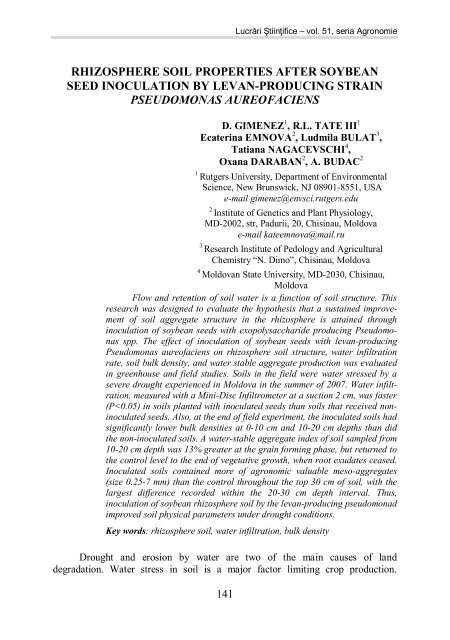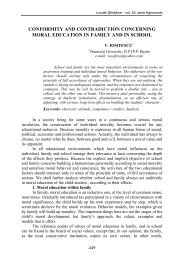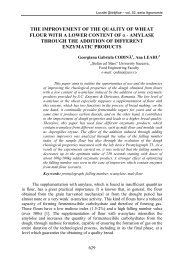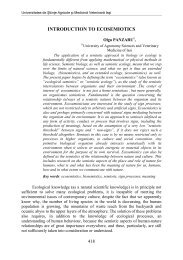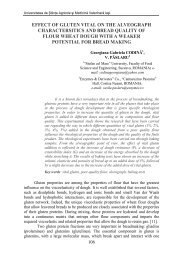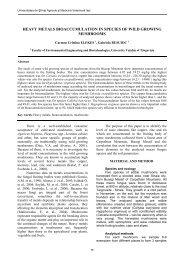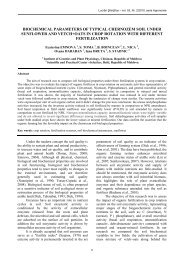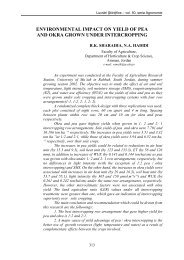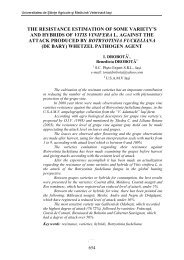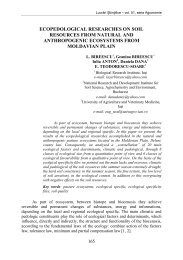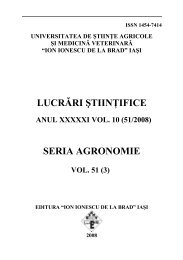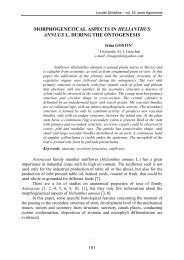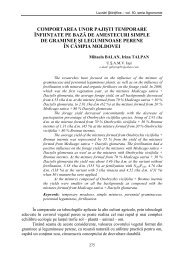rhizosphere soil properties after soybean seed inoculation by levan ...
rhizosphere soil properties after soybean seed inoculation by levan ...
rhizosphere soil properties after soybean seed inoculation by levan ...
Create successful ePaper yourself
Turn your PDF publications into a flip-book with our unique Google optimized e-Paper software.
Lucrări Ştiinţifice – vol. 51, seria Agronomie<br />
RHIZOSPHERE SOIL PROPERTIES AFTER SOYBEAN<br />
SEED INOCULATION BY LEVAN-PRODUCING STRAIN<br />
PSEUDOMONAS AUREOFACIENS<br />
D. GIMENEZ 1 , R.L. TATE III 1<br />
Ecaterina EMNOVA 2 , Ludmila BULAT 3 ,<br />
Tatiana NAGACEVSCHI 4 ,<br />
Oxana DARABAN 2 , A. BUDAC 2<br />
1<br />
Rutgers University, Department of Environmental<br />
Science, New Brunswick, NJ 08901-8551, USA<br />
e-mail gimenez@envsci.rutgers.edu<br />
2<br />
Institute of Genetics and Plant Physiology,<br />
MD-2002, str, Padurii, 20, Chisinau, Moldova<br />
e-mail kateemnova@mail.ru<br />
3<br />
Research Institute of Pedology and Agricultural<br />
Chemistry “N. Dimo”, Chisinau, Moldova<br />
4<br />
Moldovan State University, MD-2030, Chisinau,<br />
Moldova<br />
Flow and retention of <strong>soil</strong> water is a function of <strong>soil</strong> structure. This<br />
research was designed to evaluate the hypothesis that a sustained improvement<br />
of <strong>soil</strong> aggregate structure in the <strong>rhizosphere</strong> is attained through<br />
<strong>inoculation</strong> of <strong>soybean</strong> <strong>seed</strong>s with exopolysaccharide producing Pseudomonas<br />
spp. The effect of <strong>inoculation</strong> of <strong>soybean</strong> <strong>seed</strong>s with <strong>levan</strong>-producing<br />
Pseudomonas aureofaciens on <strong>rhizosphere</strong> <strong>soil</strong> structure, water infiltration<br />
rate, <strong>soil</strong> bulk density, and water stable aggregate production was evaluated<br />
in greenhouse and field studies. Soils in the field were water stressed <strong>by</strong> a<br />
severe drought experienced in Moldova in the summer of 2007. Water infiltration,<br />
measured with a Mini-Disc Infiltrometer at a suction 2 cm, was faster<br />
(P
Universitatea de Ştiinţe Agricole şi Medicină Veterinară Iaşi<br />
Bacterial production of exopolysaccharides (EPSs) in <strong>rhizosphere</strong> <strong>soil</strong> enhances<br />
water retention in the microbial and root environment, and regulates the diffusion<br />
of carbon sources [7, 8]. When inoculated to wheat roots, the EPS Levan produced<br />
<strong>by</strong> Paenibacillus polymixa improved aggregation of root adhering <strong>soil</strong> [4]. Similar<br />
effects were noted with <strong>inoculation</strong> of wheat with Pantoea agglomerans [2].<br />
Inoculation of sunflower <strong>seed</strong>s <strong>by</strong> Rhizobium sp. YAS34 resulted in modified <strong>soil</strong><br />
porosity and <strong>soil</strong> aggregate cohesion around root, and as a consequence increased<br />
nutrient uptake and prevention from water stress [1]. In the <strong>rhizosphere</strong>, plants<br />
produce exudates and stimulate bacterial activities that amplify the effect of<br />
bacterial EPS on <strong>soil</strong> property modifications. Mechanisms involved in this dynamic<br />
process are not well understood [3]. Levan and alginate are the simplest EPSs<br />
produced <strong>by</strong> rhizobacteria [12]. Effects of copper ion concentration on alginate<br />
biosynthesis <strong>by</strong> pseudomonad have been reported [11]. A Pseudomonas sp. strain<br />
increased EPS production during desiccation [13]. Thus, strains of Pseudomonas<br />
spp. that produce high levels of EPS should enhance <strong>soil</strong> aggregation, improving<br />
growth conditions for both <strong>soil</strong> microbes and higher plants. An EPS-producing<br />
strain Pseudomonas aureofaciens isolated from <strong>soybean</strong> roots growing in a<br />
Moldavian chernozem had beneficial effect on plant wet and dry biomass<br />
accumulation <strong>after</strong> <strong>soybean</strong> <strong>rhizosphere</strong> <strong>soil</strong> or <strong>seed</strong>s <strong>inoculation</strong> [9].<br />
The aim of this research was to evaluate the effect of <strong>soybean</strong> <strong>seed</strong><br />
<strong>inoculation</strong> with <strong>levan</strong>-producing Pseudomonas aureofaciens on <strong>rhizosphere</strong> <strong>soil</strong><br />
structure, water infiltration rate, <strong>soil</strong> bulk density, and water stable aggregate<br />
production.<br />
MATERIAL AND METHOD<br />
Experimental design in greenhouse condition. The experiment mimicked two<br />
types of unfavorable condition for plant cultivation: deficiency of water supply and <strong>soil</strong><br />
pollution <strong>by</strong> toxic copper at 300 ppm. A carbonate-rich chernozem <strong>soil</strong> from the<br />
Experimental Station of Moldovan Academy of Sciences (ESMAS, Chisinau, Moldova)<br />
was used. Selected <strong>soil</strong> <strong>properties</strong> were as follow: pH of 7.4; humus content of 2.47 %;<br />
particle density of 2.56 g cm -3 ; total cation exchange capacity (CEC) of 14.1 meq 100 -1<br />
g of dry <strong>soil</strong>; and water holding capacity (WHC) of 47.6 % of dry <strong>soil</strong>. For the<br />
greenhouse experiment the <strong>soil</strong> was sieved to pass 10 mm openings. A total of 64<br />
plastic pots with a volume of 7.5 kg were each filled with 5.2 kg of dry <strong>soil</strong>. In 32 of the<br />
pots, <strong>soil</strong> was contaminated <strong>by</strong> thoroughly mixing it with CuSO 4 ∙5H 2 O to achieve a<br />
copper concentration of 300 ppm. In each of the two sets of 32 pots (representing<br />
contaminated and non-contaminated <strong>soil</strong>), the following four treatments, each<br />
replicated eight times, were set up: 1) inoculated <strong>seed</strong>s, 2) non-inoculated <strong>seed</strong>s, 3)<br />
water content at 70% WHC (WC1 is equal to 33.4% of <strong>soil</strong> dry weight) and 4) water<br />
content at 35% WHC (WC2 - 16.7% of <strong>soil</strong> dry weight).<br />
Seed <strong>inoculation</strong> and plant growth condition. Soybean <strong>seed</strong>s (Glycine max L.) of<br />
the new cultivar “Zodiac” [6], grown on ESMAS were selected for the experiments.<br />
Pseudomonas aureofaciens strain PsB-03 was isolated from <strong>soybean</strong> root-adhering<br />
<strong>soil</strong> (RAS) in 2003 [9]. Bacterial suspension (10 9 colonies forming units ml -1 ) was used<br />
for <strong>seed</strong> treatment at a rate of 5·10 7 cells g -1 of dry <strong>seed</strong>. Four <strong>seed</strong>s per pots were<br />
planted at a depth of 2 cm. Initial <strong>soil</strong> water content was 50% of WHC (23.8% of dry<br />
weight). At blossom, plants were subjected to 14 days of water stress. Soil water<br />
142
Lucrări Ştiinţifice – vol. 51, seria Agronomie<br />
content treatments (70% WHC and 35% WHC) were established in subsets of pots with<br />
contaminated and non-contaminated <strong>soil</strong>. After 14 days of water stress, the plants were<br />
harvested and root-adhering <strong>soil</strong> samples were collected and analyzed.<br />
Experimental design in the field conditions. The research site was located at the<br />
ESMAS (Chisinau, Moldova). Experiment surface was 230.9 m 2 (2.7m x 85.5 m), and<br />
consisted of 2 plots, each with 3 lines of plants Zodiac from non-inoculated (control), and<br />
inoculated <strong>seed</strong>s, respectively. The distance between lines was 45 cm. Each of two plots<br />
inside was subdivided in 3 replicates. Bacterial suspension (4.5·10 8 CFU ml -1 ) was used for<br />
<strong>seed</strong> treatment at a rate of 1·10 7 cells g -1 of dry <strong>seed</strong>. Seeds were planted on 4 May, 2007<br />
with a mini-tractor supplied with <strong>seed</strong>-drill.<br />
Soil sampling. Field plots were sampled twice. The first sampling took place in July,<br />
2007 and was for characterization of bulk density and texture (day/night air temperature<br />
were 31-33 o C/23-24 o C; 2.5 month without rain and irrigation). The second sampling was<br />
conducted in August 2007 (at the end of vegetative growth) and included bulk density and<br />
infiltration rate (day/night air temperature were 25-27 o C/18-20 o C; 2 weeks <strong>after</strong> raining).<br />
Nine replicate <strong>soil</strong> samples (n=9) were extracted from depths: 0-10 cm, 10-20 cm, 20-30 cm,<br />
and 30-40 cm.<br />
Bulk density, particle density, and water content of <strong>soil</strong>. The <strong>soil</strong> bulk density (D b) -<br />
the ratio of the mass of dry solids to the bulk volume of the <strong>soil</strong> [5] - was determined with the<br />
core method, and included the effect of both the intra- and inter-aggregate pore spaces.<br />
Cores of 5.8 cm diameter x 4 cm height were used for extraction of undisturbed <strong>soil</strong> samples<br />
according to Kacinski [10]. Soil dry mass as well as <strong>soil</strong> water content were determined <strong>after</strong><br />
drying at 105 o C for 6 h.<br />
Particle-size distribution, <strong>soil</strong> structure, and aggregate water-stability determination.<br />
Soil structure of studied <strong>soil</strong>s was determined <strong>by</strong> dry sieving analysis according to Savinov<br />
[14]. Five hundred grams of <strong>soil</strong> were passed consequently through a set of sieves.<br />
Fractions collected on each sieve were weighted, and percents of nine fractions were<br />
calculated. Three size groups of structural separables were considered: micro-aggregates (<<br />
0.25 mm); meso-aggregates (between 0.25 mm and 7-10 mm - agronomic valuable), and<br />
macro-aggregates (> 7-10 mm). A coefficient of <strong>soil</strong> structure was calculated as a ratio: K =<br />
percent of meso-aggregates / (percent of macro- + micro-aggregates). Particle analyses of<br />
<strong>soil</strong> samples were made using a sedimentation procedure.<br />
Infiltration rate determination. A mini Disk Infiltrometer (Decagon Devices Inc., USA)<br />
was used for measuring of infiltration rate at a suction of 2 cm at time intervals of 30<br />
seconds. In the greenhouse experiment, the mini Disk infiltrometer was placed on the <strong>soil</strong><br />
surface at the center of each of 8 pot-replicates for each of 4 treatments and the cumulative<br />
infiltration (cm) was measured. The first measurement took place in September, 2007 and<br />
the second in April, 2008. Infiltration rate was calculated from a graph of cumulative<br />
infiltration vs. square root of time, where the slope represents the infiltration rate (i, cm s -1 ).<br />
RESULTS AND DISCUSSIONS<br />
Infiltration rates were evaluated: i) under <strong>soil</strong> water stress condition; ii)<br />
under copper-contamination condition; iii) under double stress that is water and<br />
metal stress.<br />
At an optimal value of 70% WHC, the average infiltration rate (n=8) of <strong>soil</strong><br />
planted with inoculated <strong>seed</strong>s were greater than <strong>soil</strong> planted with non-inoculated<br />
<strong>seed</strong> (figure 1), but the difference was not statistically significant because of high<br />
variability among replicates. On the other hand, infiltration rates of <strong>soil</strong> maintained<br />
at a 35% WHC were significantly (P
Universitatea de Ştiinţe Agricole şi Medicină Veterinară Iaşi<br />
2007, figure 1). The difference remained significant (P
Lucrări Ştiinţifice – vol. 51, seria Agronomie<br />
0,12<br />
0.109<br />
0,10<br />
Inoc<br />
0, 097<br />
-1<br />
s<br />
m<br />
c<br />
i,<br />
0,08<br />
Inoc<br />
0,068<br />
Inoc<br />
0,079*<br />
0,06<br />
0,04<br />
0.026<br />
0.037<br />
0.043<br />
Inoc<br />
0,040<br />
0,02<br />
0,00<br />
70% WHC 35% 2007, WHC Sept ember 2008, April 70% WHC 35% WHC<br />
Figure 2 Soil water infiltration rates, i, from the greenhouse experiment measured<br />
at two dates. Soil was contaminated with copper (300 ppm). Plants were from<br />
either inoculated (Inoc) or non-inoculated <strong>seed</strong>s and in both cases <strong>soil</strong>-plant<br />
systems were subjected to a two-week period of water stress before equilibration<br />
to two contrasting <strong>soil</strong> water contents; *P
Universitatea de Ştiinţe Agricole şi Medicină Veterinară Iaşi<br />
CONCLUSIONS<br />
Inoculation of <strong>soybean</strong> <strong>seed</strong>s <strong>by</strong> the <strong>levan</strong>-producing pseudomonad<br />
improved <strong>soil</strong> physical <strong>properties</strong> of the <strong>rhizosphere</strong> <strong>soil</strong> under drought conditions.<br />
Water infiltration rate was faster (P


